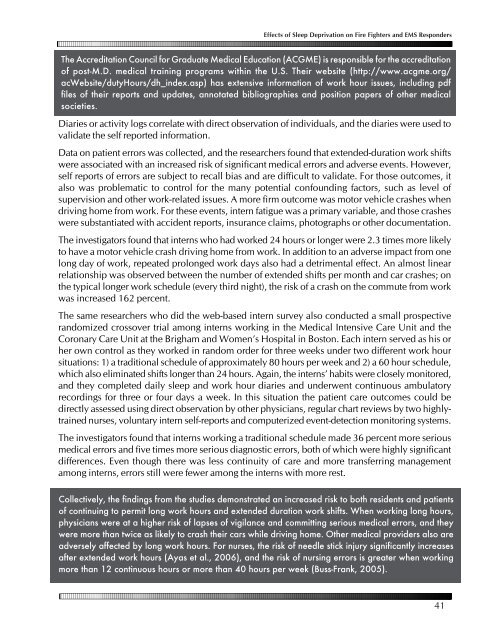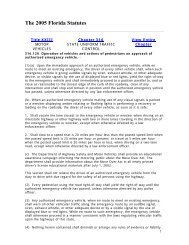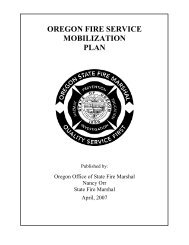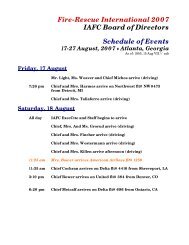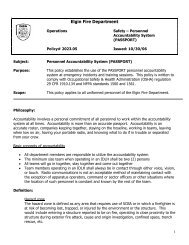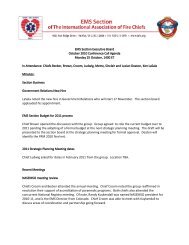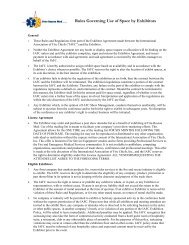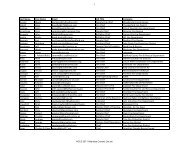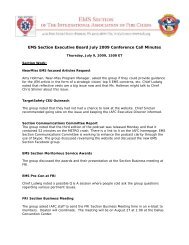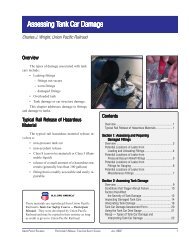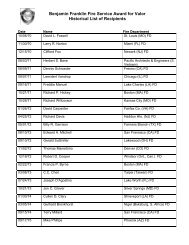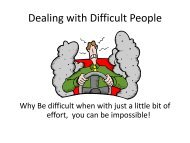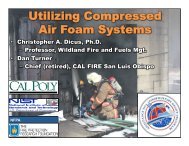Effects of Sleep Deprivation on Fire Fighters and EMS ... - NAEMT
Effects of Sleep Deprivation on Fire Fighters and EMS ... - NAEMT
Effects of Sleep Deprivation on Fire Fighters and EMS ... - NAEMT
Create successful ePaper yourself
Turn your PDF publications into a flip-book with our unique Google optimized e-Paper software.
<str<strong>on</strong>g>Effects</str<strong>on</strong>g> <str<strong>on</strong>g>of</str<strong>on</strong>g> <str<strong>on</strong>g>Sleep</str<strong>on</strong>g> <str<strong>on</strong>g>Deprivati<strong>on</strong></str<strong>on</strong>g> <strong>on</strong> <strong>Fire</strong> <strong>Fighters</strong> <strong>and</strong> <strong>EMS</strong> Resp<strong>on</strong>ders<br />
The Accreditati<strong>on</strong> Council for Graduate Medical Educati<strong>on</strong> (ACGME) is resp<strong>on</strong>sible for the accreditati<strong>on</strong><br />
<str<strong>on</strong>g>of</str<strong>on</strong>g> post-M.D. medical training programs within the U.S. Their website (http://www.acgme.org/<br />
acWebsite/dutyHours/dh_index.asp) has extensive informati<strong>on</strong> <str<strong>on</strong>g>of</str<strong>on</strong>g> work hour issues, including pdf<br />
files <str<strong>on</strong>g>of</str<strong>on</strong>g> their reports <strong>and</strong> updates, annotated bibliographies <strong>and</strong> positi<strong>on</strong> papers <str<strong>on</strong>g>of</str<strong>on</strong>g> other medical<br />
societies.<br />
Diaries or activity logs correlate with direct observati<strong>on</strong> <str<strong>on</strong>g>of</str<strong>on</strong>g> individuals, <strong>and</strong> the diaries were used to<br />
validate the self reported informati<strong>on</strong>.<br />
Data <strong>on</strong> patient errors was collected, <strong>and</strong> the researchers found that extended-durati<strong>on</strong> work shifts<br />
were associated with an increased risk <str<strong>on</strong>g>of</str<strong>on</strong>g> significant medical errors <strong>and</strong> adverse events. However,<br />
self reports <str<strong>on</strong>g>of</str<strong>on</strong>g> errors are subject to recall bias <strong>and</strong> are difficult to validate. For those outcomes, it<br />
also was problematic to c<strong>on</strong>trol for the many potential c<strong>on</strong>founding factors, such as level <str<strong>on</strong>g>of</str<strong>on</strong>g><br />
supervisi<strong>on</strong> <strong>and</strong> other work-related issues. A more firm outcome was motor vehicle crashes when<br />
driving home from work. For these events, intern fatigue was a primary variable, <strong>and</strong> those crashes<br />
were substantiated with accident reports, insurance claims, photographs or other documentati<strong>on</strong>.<br />
The investigators found that interns who had worked 24 hours or l<strong>on</strong>ger were 2.3 times more likely<br />
to have a motor vehicle crash driving home from work. In additi<strong>on</strong> to an adverse impact from <strong>on</strong>e<br />
l<strong>on</strong>g day <str<strong>on</strong>g>of</str<strong>on</strong>g> work, repeated prol<strong>on</strong>ged work days also had a detrimental effect. An almost linear<br />
relati<strong>on</strong>ship was observed between the number <str<strong>on</strong>g>of</str<strong>on</strong>g> extended shifts per m<strong>on</strong>th <strong>and</strong> car crashes; <strong>on</strong><br />
the typical l<strong>on</strong>ger work schedule (every third night), the risk <str<strong>on</strong>g>of</str<strong>on</strong>g> a crash <strong>on</strong> the commute from work<br />
was increased 162 percent.<br />
The same researchers who did the web-based intern survey also c<strong>on</strong>ducted a small prospective<br />
r<strong>and</strong>omized crossover trial am<strong>on</strong>g interns working in the Medical Intensive Care Unit <strong>and</strong> the<br />
Cor<strong>on</strong>ary Care Unit at the Brigham <strong>and</strong> Women’s Hospital in Bost<strong>on</strong>. Each intern served as his or<br />
her own c<strong>on</strong>trol as they worked in r<strong>and</strong>om order for three weeks under two different work hour<br />
situati<strong>on</strong>s: 1) a traditi<strong>on</strong>al schedule <str<strong>on</strong>g>of</str<strong>on</strong>g> approximately 80 hours per week <strong>and</strong> 2) a 60 hour schedule,<br />
which also eliminated shifts l<strong>on</strong>ger than 24 hours. Again, the interns’ habits were closely m<strong>on</strong>itored,<br />
<strong>and</strong> they completed daily sleep <strong>and</strong> work hour diaries <strong>and</strong> underwent c<strong>on</strong>tinuous ambulatory<br />
recordings for three or four days a week. In this situati<strong>on</strong> the patient care outcomes could be<br />
directly assessed using direct observati<strong>on</strong> by other physicians, regular chart reviews by two highlytrained<br />
nurses, voluntary intern self-reports <strong>and</strong> computerized event-detecti<strong>on</strong> m<strong>on</strong>itoring systems.<br />
The investigators found that interns working a traditi<strong>on</strong>al schedule made 36 percent more serious<br />
medical errors <strong>and</strong> five times more serious diagnostic errors, both <str<strong>on</strong>g>of</str<strong>on</strong>g> which were highly significant<br />
differences. Even though there was less c<strong>on</strong>tinuity <str<strong>on</strong>g>of</str<strong>on</strong>g> care <strong>and</strong> more transferring management<br />
am<strong>on</strong>g interns, errors still were fewer am<strong>on</strong>g the interns with more rest.<br />
Collectively, the findings from the studies dem<strong>on</strong>strated an increased risk to both residents <strong>and</strong> patients<br />
<str<strong>on</strong>g>of</str<strong>on</strong>g> c<strong>on</strong>tinuing to permit l<strong>on</strong>g work hours <strong>and</strong> extended durati<strong>on</strong> work shifts. When working l<strong>on</strong>g hours,<br />
physicians were at a higher risk <str<strong>on</strong>g>of</str<strong>on</strong>g> lapses <str<strong>on</strong>g>of</str<strong>on</strong>g> vigilance <strong>and</strong> committing serious medical errors, <strong>and</strong> they<br />
were more than twice as likely to crash their cars while driving home. Other medical providers also are<br />
adversely affected by l<strong>on</strong>g work hours. For nurses, the risk <str<strong>on</strong>g>of</str<strong>on</strong>g> needle stick injury significantly increases<br />
after extended work hours (Ayas et al., 2006), <strong>and</strong> the risk <str<strong>on</strong>g>of</str<strong>on</strong>g> nursing errors is greater when working<br />
more than 12 c<strong>on</strong>tinuous hours or more than 40 hours per week (Buss-Frank, 2005).<br />
41


